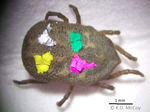
LACHISH Shelly
Recommendations: 0
Review: 1
Review: 1

Evaluating functional dispersal and its eco-epidemiological implications in a nest ectoparasite
Limited dispersal in a vector on territorial hosts
Recommended by Adele Mennerat based on reviews by Shelly Lachish and 1 anonymous reviewerParasitism requires parasites and hosts to meet and is therefore conditioned by their respective dispersal abilities. While dispersal has been studied in a number of wild vertebrates (including in relation to infection risk), we still have poor knowledge of the movements of their parasites. Yet we know that many parasites, and in particular vectors transmitting pathogens from host to host, possess the ability to move actively during at least part of their lives.
So... how far does a vector go – and is this reflected in the population structure of the pathogens they transmit? This is the question addressed by Rataud et al. [1], who provide the first attempt at using capture-mark-recapture to estimate not only functional dispersal, but also detection probability and survival in a wild parasite that is also a vector for other pathogens.
The authors find that (i) functional dispersal of soft ticks within a gull colony is very limited. Moreover, they observe unexpected patterns: (ii) experimental displacement of ticks does not induce homing behaviour, and (iii) despite lower survival, tick dispersal was lower in nests not containing hosts than in successful nests.
These results contrast with expectations based on the distribution of infectious agents. Low tick dispersal within the colony, combined with host territoriality during breeding and high site fidelity between years should result in a spatially structured distribution of infectious agents carried by ticks. This is not the case here. One possible explanation could be that soft ticks live for much longer than a breeding season, and that they disperse at other times of year to a larger extent than usually assumed.
This study represents one chapter of a story that will likely keep unfolding. It raises fascinating questions, and illustrates the importance of basic knowledge of parasite ecology and behaviour to better understand pathogen dynamics in the wild.
References
[1] Rataud A., Dupraz M., Toty C., Blanchon T., Vittecoq M., Choquet R. & McCoy K.D. (2019). Evaluating functional dispersal and its eco-epidemiological implications in a nest ectoparasite. Zenodo, 2592114. Ver. 3 peer-reviewed and recommended by PCI Ecology. doi: 10.5281/zenodo.2592114